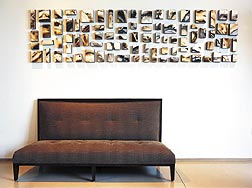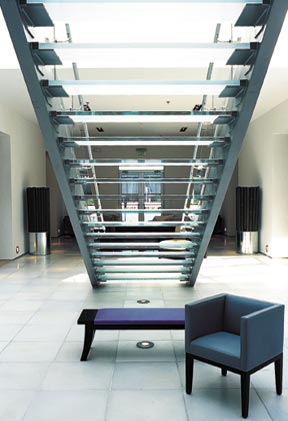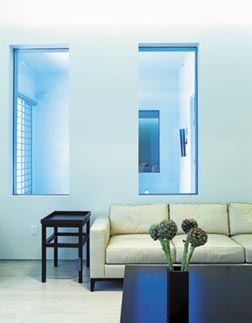HOLLY DAY
Design diva Nisi Berryman
oversees the vision of
Holly Hunt in Miami
By Daniela Schimmel
Photographs by Eric
Laignel |
| An assemblage by Lisa Ariotti using pigment and ink, mounted on wooden blocks, and a Lorin Sofa by Christian Liaigre illustrate the ability of modern art to expand space. |
 |
Design snobs looking for the
latest and greatest in home furnishings no longer need to hop
a jet to New York or London. Over the past two years, more
than 50 stores have opened in Miami's Design District, so
décor divas on a quest for that jenesaisquoi can simply head
downtown.
And with the addition of Holly Hunt's spectacular
show room to the area, even the most upturned noses are
impressed. Hunt's sleek two-story decorating wonderland offers
a variety of sought-after furniture lines as well as its own
important namesake collection, not only quenching the thirst
of finicky South Floridians but attracting architects and
buyers from around the world. At the helm of the loftlike
space is Nisi Berryman, who, like so many of our favorite
locals, is a New York transplant. She made her mark on the
ultracool Dakota Jackson before bringing her sophisticated
style to sunny Miami. |
 |
 |
| A steel and glass
staircase under the skylight in the Holly Hunt show room
illustrates the power of light, creating an airy,
tropical feeling. Fabrics are shown upstairs in the
luxury of natural daylight. The sleek, chic show room
was designed by Alison
Spear. |
For those
who may not be familiar with the name Holly Hunt, how would
you classify the style of furniture available in her show
rooms?
Sophisticated and
comfortable.
Tell us about Holly the person. Why
is she regarded so highly in the design
community?
Holly is a totally dynamic
businesswoman, but also has a great sense of creativity. She
has an amazing eye. She likes to call herself an editor. She
is just very strong in knowing what works. When she started
her business in the '80s she was in a small show room in the
Merchandise Mart in Chicago. Her idea was to change the
display of furniture. She wanted to alter the way people
experience shopping when they go to a trade show room. She
paid attention to how things look, how people feel when they
walk in the room, how materials are presented to the customer.
She didn't make any furniture at that point. She only
represented other designers, and made sure the companies she
represented looked great. It was all done with such
style.
The design scene is always in transition.
How has it changed since the '80s?
Design went
through a rough period when there was just way too much bad
stuff. People latched on to a very traditional look that can
easily bejunked up. Classic styles can be surprisingly hard to
pull off. Now we're seeing this nice refreshing movement away
from all that to really simple spaces that are more nurturing
to your spirit. They are not cluttered, fussy or ostentatious.
The modern space is clean and feels good to be in. These days
it's not about showing how much money you have. It's about
personal style.
In terms of sophistication, how
does Miami compare with other cities?
Miami is just
totally unedited. It's not refined. You can find amazing style
here and also the trashiest style. You see all of it, but that
kind of makes it Miami.

Nisi
Berryman, the general manager of the Holly Hunt show
room, is seated on a Chamane
Chair. |
Where are
you from?
I grew up in Mississippi, but after
school at Louisiana State University, I went to New York and
worked in Manhattan for some galleries. Eventually, I got into
furniture and ended up working for Dakota Jackson for six
years. He was just moving from being a one-man operation to
having a Manhattan show room, and then to others around the
country. It was an exciting time, and design was the hot
topic.
Since a sense of style cannot be taught,
how do women like Holly become so cool?
Speaking
for Holly, she draws a lot from art. She collects modern art.
Anybody in design typically gets inspiration from diverse
things like the edge of a napkin or the corner of a building.
Holly also gets a lot of inspiration from
architecture.
With five show rooms open all over
the country, what's next?
She is opening a second
store in Manhattan on the street and Christian Liaigre is
doing the interior. This is going to be a real departure
because, apart from Miami, all her show rooms are in design
centers.
What is the first purchase for someone
who wants to upgrade their space?
A dining table.
Sofas are also very important. The good thing about sofas is
that the really high-quality ones last 50
years.
How have pop culture and magazines like
Wallpaper contributed to making design more accessible to the
general public?
Design really is everywhere. It
affects everything you do every day. Everything you touch or
look at-if it's not part of the natural landscape-was designed
by somebody, and you know if it's not working. A bad town
layout, a bad building design, a bad cabinet design affects
the whole area and your perceptions. The more people pay
attention and learn about design, the more it benefits
everyone. People find their lives are enhanced by living with
design, and that's really what this whole boom is
about.
Would you say the trend right now is more
eclectic and diverse?
Sure, because the more people
are educated, the more confident they are about the pieces
they pick. I enjoy seeing the juxtaposition of styles in one
room. But you have to be careful. You have to edit. One style
can't overpower the other. You have to pick pieces that really
live well together.
What is the most common
decorating mistake?
People don't pay enough
attention to lighting. They spend a lot of time working out
details, finding the right pillows, and then stick a halogen
lamp in the corner and call it done. Good lighting can really
make all the difference. |
 |
The Muse Table with a removable tray, Mousson
Sofa and Charpentier Coffee Table.
| |
| |

